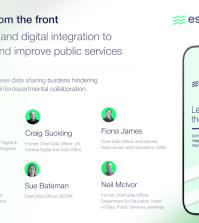Sunil Shahaney, former Director of the Debt Programme, Cabinet Office, UK: Exclusive Interview

In 2011, the UK mounted a cross-government drive to shrink its $26bn pile of outstanding debts. Programme head Sunil Shahaney explains to Matt Ross how he got ministers and departments collaborating on this complex, challenging task
What’s required to run change programmes in the civil service? Sunil Shahaney has the answer in a nutshell – or, rather, two nutshells.
First, “the right behaviours and experience, and an open mind. You need to listen rather than preach, and to understand the big picture and the political dynamics,” he says. Second, “you need political cover for delivering policy – so the role of ministers is hugely important. You need their commitment to the agenda.”
And these days, for many projects we can add a third nutshell: commercial and business skills, like those Shahaney brought into government in 2003 when he left his 20-year private sector career for an assistant director’s job at the UK’s Department for Business, Innovation and Skills. From 2006 he was head of commercialisation at Partnerships UK, a Treasury-owned business responsible for “sweating assets”: building public-private partnerships to improve the revenue generated by public bodies. And in 2011, he took on a newly-created role at the heart of government.
Installed as director of the Cabinet Office’s debt programme, Shahaney’s new role provided a neat mirror image of his responsibilities at Partnerships UK. There, he had been tasked with maximising revenues from government operations; at the Cabinet Office, it was his job to minimise losses to fraud, error and unpaid debts. Held and managed by organisations scattered across government, overdue debts were then estimated at over £20bn ($26bn) – the same as the UK’s entire transport budget. Building and delivering a plan to shrink that figure would demand advanced skills in finance, process management and organisational change.
A new range of skills
And did his civil service colleagues understand the value of private sector skills inside government? When he first joined the civil service in 2003, “there was very little appreciation and understanding of why the government needed those skills,” he replies. “The decision-makers had implemented a policy [to hire more external candidates], but my colleagues who had a typical policy background didn’t appreciate why a person with no knowledge of Parliament, legislation or policy was being brought in. I was told a couple of times by senior people: ‘We don’t get it’.”
Over the last 15 years, though, that’s changed: nowadays “there’s an acknowledgement that we need a diversity of skills, opinions and experience in the civil service to make it work,” he continues. “And as the world gets more complex and joined-up, and we have more common problems – like the 2008 financial crisis – I think there’ll be an increasing realisation that we need to be even more diverse and have even more specialist skills.”
Indeed, Shahaney’s commercial skills were particularly well-suited to the era of austerity, which had begun in earnest with the Coalition’s election in 2010. For he’d spent much of his business career in India – and the “key attribute of emerging markets is affordability,” he notes. “Affordability then drives important behaviours: customer centricity, creativity, innovation. When you don’t have money, you start to become more creative.”
A wider range of people
As well as recruiting more senior civil servants from outside government, the government has also attempted to improve the ethnic diversity of its leadership cadre. But despite his business background, Shahaney – a British Indian – is unconvinced by the government’s reliance on setting out a ‘business case’ for diversity. For years, civil service leaders have argued that “if you have a diverse workforce, you perform better,” he says. “But I think there’s a problem with that approach: it’s conditional on business imperatives.” And that downplays the values-based case, he believes: “Government shouldn’t shy away from the moral and ethical arguments.”
Some 12% of civil servants are from ethnic minorities, he points out; yet within the senior civil service, the proportion has only just reached 5%. “I’m convinced government is serious about bridging the gap,” he says. “But I don’t see evidence that there’s a big change in the numbers. I think the government needs to be more ambitious; much bolder – and not only on ethnicity, but on disability and age too.”
He’s not a fan of quotas, though – arguing that government should instead publish the data gathered on ‘protected characteristics’ during recruitment processes, revealing where the mix of recruits doesn’t reflect the diversity of candidates. “Publishing these statistics would focus minds,” he argues. “You’re collecting the data: let’s use it!”
In debt to data
Gathering and using data also featured high on Shahaney’s ‘to do’ list when he first took the debt job – for with no central oversight of debt management across government, his first challenge was to understand the scale and nature of the problem. A year-long research programme identified 17 departments collecting debts; 86 inter-departmental data-sharing protocols; and some 13,000 staff – nearly 3% of the entire workforce – involved in debt management. Most of the debts owed to the biggest departments – HM Revenue & Customs, and the Department of Work & Pensions – was more than six months overdue, and every year government was writing off about £6bn ($8bn) deemed not economically recoverable.
Working with a ministerial steering group, Shahaney and Cabinet Office minister Francis Maude produced an interim strategy built around four key principles. Efficiency involved “removing departmental silos” and creating common processes, reducing duplication across government. Effectiveness meant “supporting departments to better manage their systems, processes and data collection,” and spreading best practice. Prevention – or compliance – focused on preventing debts from arising in the first place by reducing fraud, error and late payment. And ‘fairness’ meant taking a new line on enforcement – with “tough action on those who avoid payment when they could afford it, whilst supporting those who genuinely need help.”
“We needed to do something tactical on those who could pay but wouldn’t – to send a message” to those evading debts, he adds. “But the long-term, strategic intent of the policy was to focus on compliance; that’s the most cost-effective way to reduce debt.”
What tools and processes did Shahaney’s team create to pursue their four-pronged agenda? One early priority was to improve data-sharing across government so that, for example, civil servants could see whether individuals owed money to more than one department – something that required legislative change. Shared codes of practice were developed, and the Cabinet Office encouraged departments to adopt ‘nudge’ behavioural economics techniques: “We ran pilots with departments,” he recalls. “So, for example, HMRC changed the tone of their letters – putting honesty up front” and emphasising that most people do pay government what they owe.
A joint adventure
Meanwhile, the Cabinet Office set out to reduce duplication in debt collection: with departments using a host of different suppliers, government was missing opportunities to generate economies of scale; to hold a single conversation with citizens about their debts across government; and to “better use data to tease out the vulnerable from the ‘can pays’,” comments Shahaney.
Rather than simply combining its debt collection contracts then contracting a single supplier, government decided to create a joint venture (JV): this gave it “skin in the game,” he says, and ensured that it could “participate in the outcomes of good performance.” Though the JV was to manage only debt collection operations – covering two or three percent of the £22bn owed to government – Shahaney says it was an “important delivery mechanism” in pursuing the “fairness” principle.
The decision to create a JV wasn’t straightforward, he explains: “Government had had patchy outcomes from the few JVs that had operated, and there was a lot of scrutiny from the departments.” But the model didn’t involve taking control of departments’ debts – sidestepping concerns that officials would become accountable for services which they didn’t control. “HMRC still get directly involved with the JV in terms of operations and funding, and drive the outcomes from their [debt] book,” he explains. “The accountability still sits with the departments.” This was, in essence, a central service to departments rather than a shared service taking over their responsibilities.
In 2016, Shahaney moved over to work for the JV, which had been established with the UK firm TDX Group. For government, he suggests, this had the advantage of ensuring that the JV would prioritise public policy goals alongside financial performance: “There were a number of non-financial issues which were part of the business objective; fairness was of huge importance,” he says. “A JV is a commercial entity, and there needs to be a critical friend – for want of a better term – to ensure it’s a broader conversation: to focus on smaller departments, to help with skills and expertise, to ensure there’s fairness.”
And how did government ensure that TDX didn’t benefit commercially from his appointment? “I had absolutely no role in the selection process, or in engaging with the supplier,” he explains. “They were selected through a competitive tender by a procurement team that sat in HMRC.” To ensure that Shahaney’s relationships with former civil service colleagues couldn’t influence decisions as the JV contract neared a break-point, he was employed on a fixed-term contract; and he’s now left the business. “I have no role with the company as they’re going to re-procurement or contract extension or whatever,” he says.
Making movement
Looking back at his time in the civil service, Shahaney identifies a handful of key factors that helped him to shift and align government’s debt operations. “Getting Treasury on board was hugely important; they have the financial levers that the Cabinet Office lacks,” he says. And a National Audit Office report on the topic proved pivotal; for that prompted hearings by the House of Commons’ Public Accounts Committee, at which senior HMRC and DWP figures pledged to act on debt. “They were sitting in front of the committee giving commitments, so that created momentum,” he comments.
Returning to Shahaney’s second nutshell, the presence of “a determined Cabinet Office minister who was committed to efficiency was a very important lever.” Maude’s ministerial task force enabled him to work on departments’ political leaders whilst Shahaney engaged with their officials; and the minister also produced a joint report with HMRC and DWP secretaries of state, “setting out the vision – which then committed the departments to moving to the next phase.” If the government has progressed on the debt agenda, he adds, much of the credit should lie with Maude: he “recognised that the government needed to keep pace with changing circumstances, and to have an innovative culture which permitted trying out sensible new ideas.”
Ultimately, though, political impetus wouldn’t have produced a result without that first nutshell: an open mind, and the right behaviours. In part, this meant moving incrementally; for with data in 2011 so weak, any big leap would have been one into the dark. “We had to do something on the basis of the broad evidence we had, gather more evidence, and fine-tune it as we went along,” he recalls.
And it meant moving in step with partners across government: the people who held both the ultimate responsibility for collecting debt, and the greatest expertise in doing so. “I’m not a debt expert: the expertise sat with departments, and they understood what they were doing,” says Shahaney. “We were using levers, but we had to carry operational people with us. So I got the facts and figures; I brought in external specialists. But it was about listening: I did a lot of listening.”
Global Government Forum: Five Thoughts for Better Government
Sunil Shahaney on learning from overseas
To help our readers get the best out of Global Government Forum, we ask interviewees five standard questions – four seeking practical advice and opinions, and one to reveal something a little more personal. This is an edited version of Shahaney’s answers.
Can you name one lesson or idea from abroad that’s helped you or your colleagues?
“The experience of working in an emerging market has been hugely influential in shaping my approach to problem-solving. A common attribute to emerging markets is affordability, and affordability drives behaviours… creativity, innovation, [being] more customer centric.
“The example I will quote is from Kenya. There was a mobile payment platform launched in Kenya in 2007, M Pesa, and it involved using a normal, very simple mobile phone. There are four million bank users in Kenya, and 17 million users of M Pesa. That gives you an idea of the kind of technologies that emerge from these markets, in terms of social impact.”
Are there any projects or innovations from this country that might be valuable to your peers overseas?
“What the UK government has done on public private partnerships is one that we can share. Not everything has been good in terms of outcomes, but… the policy has been politically durable. To address the challenges in terms of infrastructure, I think we need to engage with the private sector. I read the other day that the infrastructure gap globally is around $30 trillion, and to fund that… we’ll need to work with the private sector.”
How can we improve the ways in which senior public officials work with and learn from their colleagues overseas?
“There’s nothing like hands-on experience, but we need to be practical: we live in a financially constrained environment. And we have a lot of digital tools now to bring the world closer: we have products such as Global Government Forum, where we can share case studies and good practice and experiences. So I would suggest more webinars, more events, more conferences to exchange thoughts and ideas.
“But I’ll go back to my emerging market theme. I think we need to look beyond the developed world, because there are lots of good examples from the emerging markets in terms of affordability and innovation and creativity.”
What are the biggest global challenges in your field over the next couple of years?
“I’ve worked across a number of policy areas: when you’ve worked in the private and public sectors for over 40 years, then you cover broad areas. So, two issues that are important for me.
“One is equality. I think we have a challenge. There’s a House of Commons Report published recently which basically says that two thirds of the world’s assets are going to sit with one percent of the population. So equality within nations and between nations is going to be a big challenge as we move forward.
“The other one I’d raise is the impact of technology on biology. We talk about driverless cars, the internet and all of that, but I think technology is going to have a profound impact on disease, on understanding how the brain works. And the impact of that is going to be for civil servants on policy development.”
And finally, what’s your favourite book?
“One that stands out is a book I read a few years ago called The Wisdom of Crowds by James Surowiecki. His thesis is that crowds are much better at predicting the future than individual experts. It’s an interesting conundrum – and counterintuitive, as most conundrums are – and the example he cites which has stuck in my mind is from the TV programme ‘Who Wants to Be a Millionaire’ [on which contestants unsure of an answer can ask either the audience or a friend for advice]. The statistic he quotes is that if you ask the audience, they get the answer right around 90% of the time; if you ask the friend, they get the right answer 65% of the time. An interesting conundrum, and a book worth reading.”























